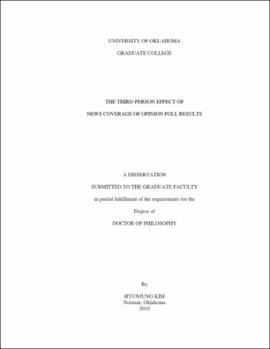| dc.contributor.advisor | Hensen, Glenn J | |
| dc.creator | KIM, HYUNJUNG | |
| dc.date.accessioned | 2019-04-27T21:38:02Z | |
| dc.date.available | 2019-04-27T21:38:02Z | |
| dc.date.issued | 2010 | |
| dc.identifier | 99363519302042 | |
| dc.identifier.uri | https://hdl.handle.net/11244/319211 | |
| dc.description.abstract | The objective of the present study was to examine 1) the differential third-person perception (TPP) of the opinion poll reports and 2) whether and how the TPP is associated with its consequences -- attitude change and behavioral intention change. As the method, an experiment was conducted with a 2 (message position: pro-restriction vs. anti-restriction) by 2 (subject position: pro-restriction vs. anti-restriction) by 2 (others: in-group/out-group) mixed factorial design with message position and subject position as between-subjects factors and others as a within-subjects factor. The stimuli were news articles reporting the results of an opinion poll on the government restrictions on violent TV programming. | |
| dc.description.abstract | The findings demonstrate participants' attitude toward the government restrictions on violent TV programming changed after they read the news report of opinion poll results. Regarding the differential TPP, message position and others interacted with each other on the TPP of the poll results although the predicted 3-way interaction among message position, subject position, and others was not statistically significant. Regarding the association between TPP and its consequences -- attitudinal change and behavioral intention change, the TPP was significantly associated with the attitudinal change, and anxiety mediated the association. However, the TPP was not associated with behavioral intention. | |
| dc.description.abstract | The present study contributes to the TPE research by revealing the role of anxiety as a mediator in the linkage between the TPP and attitudinal change and confirming that people's predisposition on a message and its target group affects the perceived effect of the message. For future research, more studies examining the TPE in diverse contexts with different types and levels of involvement and different types of emotion are suggested. | |
| dc.format.extent | 122 pages | |
| dc.format.medium | application.pdf | |
| dc.language | en_US | |
| dc.relation.requires | Adobe Acrobat Reader | |
| dc.subject | Mass media--Psychological aspects | |
| dc.subject | Mass media--Social aspects | |
| dc.subject | Persuasion (Psychology) | |
| dc.subject | Public opinion--United States | |
| dc.subject | Public opinion polls | |
| dc.title | The third-person effect of news coverage of opinion poll results | |
| dc.type | text | |
| dc.type | document | |
| dc.thesis.degree | Ph.D. | |
| ou.group | College of Arts and Sciences::Department of Communication | |
